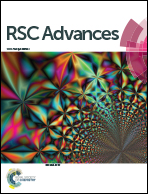Mono- and binuclear palladacycles via regioselective C–H bond activation: syntheses, mechanistic insights and catalytic activity in direct arylation of azoles†
Abstract
Regioselective C–H bond palladation of the hybrid pincer-type ligands, 3-R2PO-C6H4-1-CH2NiPr2 [R2POCNiPr2–H; R = Ph (1a), R = Et2N (1b)] has been described to accomplish mono- and binuclear palladacycles. The reactions of the ligands R2POCNiPr2–H (1a, 1b) with Pd(COD)Cl2 in the presence of K3PO4 afforded the mononuclear pincer complexes {κP,κC,κN-2-(R2PO)-C6H3-6-(CH2NiPr2)}PdCl (R2POCNiPr2)PdCl [R = Ph (2a), R = Et2N (2b)], whereas similar reactions in the presence of Et3N produced the chloro-bridged binuclear palladacycles [{κP,κC-2-(R2PO)-C6H3-4-(CH2NiPr2)}(μ-Cl)Pd]2 {R = Ph (4a), R = Et2N (4b)} via the regioselective ligands C(2)–H and C(4)–H bond activation, respectively. Similarly, the reaction of a previously reported ligand iPr2POCNiPr2–H (1c) with Pd(COD)Cl2 in the presence of Et3N affords a chloro-bridged binuclear complex [{κP,κC-2-(iPr2PO)-C6H3-4-(CH2NiPr2)}(μ-Cl)Pd]2 (4c) via the regioselective C(4)–H bond palladation. On the contrary, using Pd(OAc)2 instead of Pd(COD)Cl2 in the palladation reaction of 1a, in the presence or absence of base, leads to the exclusive formation of the acetate-bridged binuclear palladacycle [{κP,κC-2-(Ph2PO)-C6H3-4-(CH2NiPr2)}(μ-OAc)Pd]2 (5a). Mechanistic detail for this regioselective C–H bond activation to achieve mono- and binuclear palladacycles has been demonstrated, which highlights that the coordinating ability of the external base, sterics between the coordinated base and N-arm of the POCN ligand as well as the electrophilicity of the palladium center are crucial to the regioselective palladation. The palladium complex 4c was shown to be the active catalyst for the direct arylation of azoles with aryl iodides under mild reaction conditions.


 Please wait while we load your content...
Please wait while we load your content...